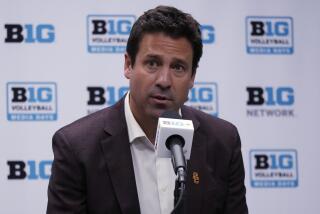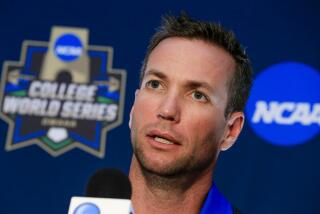College Basketball : Lack of National TV Hurts Pac-10
- Share via
So we’re getting ready for another Pacific 10 basketball season. USC Coach Stan Morrison calls it the second season. It follows the first--nonconference games--and determines whether there will be a third, the NCAA tournament.
For the Pac-10 and the West Coast in general, there has been only a second season in recent years.
The Pac-10 is represented, of course, in the NCAA playoffs but not for long. It’s an achievement if the teams can survive the first round.
Take last season, for example. USC, Washington, Oregon State and Arizona were all eliminated in the first round.
The conference has had only one representative, UCLA, in the Final Four since 1977.
The power base is in the East--there were three Big East teams in the Final Four last season--with the Atlantic Coast Conference, Big Ten and Southeastern Conference eminently respectable.
Some people say that it’s just cyclic, that the Pac-10 will make a comeback. Ralph Miller, Oregon State’s veteran coach, may be more realistic. He says that the general caliber of West Coast basketball won’t improve until some dominating centers surface, and that the lack of exposure on national television is hurting recruiting on the West Coast.
“The last dominating center we (Pac-10) had was Bill Walton (UCLA) and that was a long time ago in the 70s,” Miller said. “Before that, UCLA had Kareem Abdul-Jabbar. The only one besides those two was Bill Cartwright of USF. He wasn’t a franchise but he was a pretty good-sized guy.
“It’s virtually impossible to get to the NCAA Final Four unless you have some dominating post people.”
There aren’t any on Pac-10 teams this season, with the possible exception of Washington’s Chris Welp, a 7-foot center from West Germany.
“If you’re going to be reasonable, you’re not going to be rated among the top five or six teams in the country without a dominating post man,” Miller said. “Those who do exist aren’t residents of the West Coast.”
There is another factor blocking West Coast teams from ascending to the Final Four. The NCAA now balances the field by sending one of the top-seeded teams, such as Georgetown, North Carolina, or St. John’s, to the West Regional, where they expose the brand of West Coast basketball by mopping up on the way to the finals.
The West is represented in the Final Four by the East.
Television is also playing a major role in keeping the Pac-10 subservient, according to Miller.
“Our recruiting has been hurt because of television,” Miller said. “It doesn’t matter what the rest of us do, nobody gets on (national) TV except for UCLA. If they can’t make a show, bingo, that takes care of the West Coast.
“We (Oregon State) were champions for four years and we got two appearances on national television. But there aren’t enough people to watch television up here as far as the national scene is concerned and there is a time factor involved. I can understand that from a business standpoint.
“There is another thing. We (West Coast) lost one of our very best players (Scott Williams) to North Carolina this year. His reason? He could be seen on television all the time.
“You take the whole television network and it is totally dominated by a few teams and most of them are in highly populated areas. So television is helping those teams to recruit.
“What am I going to say? We’re on television 17 times but who the hell sees us. Now we’ve been on the doubleheader program of CBS and NBC in recent years, but that 3 o’clock game on the West Coast is not seen past the Rocky Mountains.
“The past two years, I’ve gone back to New York representing the Pac-10 in a sense. I’ve talked to NBC, CBS and ABC and it’s not going to change. The only thing they have on the West Coast with any popularity and population is Los Angeles.”
Miller said that Eastern and Southern schools, who used to recruit in their own areas, are enticing highly regarded West Coast recruits away from their home base with television as a lure.
“Here is St. John’s now recruiting a guard in the Bay Area,” he said. “They used to leave us alone. We weren’t fighting the Midwest, South and East until the last four or five years. They can sell them on national TV exposure.
“Now any kid coming out of high school with any talent is dreaming of becoming a pro. Television doesn’t make you a pro, but it sure doesn’t hurt you.
“On the other hand, you have one of the outstanding new pros in A.C. Green (former Oregon State star now with the Lakers). But he was the least known of the first-round draft choices. Yet there is no question had he been playing on television with UCLA or Notre Dame, he would have been much higher on the draft list and better paid.”
Miller can’t do much about the television situation, or the present population base in the Pacific Northwest. But he can look for prospective dominating centers in places where other schools haven’t scoured the area.
“We went to a place nobody has been,” said the 66-year-old Miller, the winningest active college coach. “We went to Argentina.”
He was referring to a future recruit, 7-1 Fernando Borcel, who is currently playing at Oak Hill Academy in Virginia.
Miller can only hope that the Argentine isn’t twisting the TV dial, trying to find the Beavers on the tube.
More to Read
Go beyond the scoreboard
Get the latest on L.A.'s teams in the daily Sports Report newsletter.
You may occasionally receive promotional content from the Los Angeles Times.










